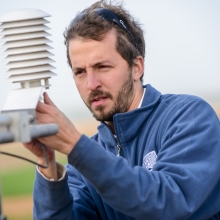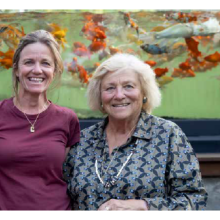Weizmann and Curie: a new partnership
The two institutions launch a formal scientific collaboration
Features

The Weizmann Institute of Science and Institut Curie in Paris signed a collaboration agreement in March that will enable their scientists to work together to advance knowledge and discovery in the life sciences, physics and chemistry, and with an emphasis on cancer research. The partnership, which relies on philanthropic support, builds on existing collaborative work between the two institutions over the last 15 years, particularly in biophysics.
The new partnership will extend to cellular biology, epigenetics, genetics, immunology, single-cell sequencing, and beyond. Each joint research project will receive support through a call-for-proposals process, with proposals selected by a steering committee. It will also involve Curie-Weizmann symposiums every two years, in Rehovot and Paris.
To finance the collaboration, the institutions have launched a fundraising campaign that is expected to fund multiple projects annually.
Joint projects to date have included studies on defects in cell nuclei, the mechanics of cell migration, and the behavior of neural networks.
The Weizmann Institute’s Prof. Nir Gov of the Department of Chemical and Biological Physics participated in several collaborative projects ranging from cell migration to collective cell behaviors and neuron growth. With Prof. Raphael Voituriez of the Sorbonne University, he developed a theory that explains the observations of Prof. Matthieu Piel of Institut Curie on the links between persistence and speed of migrating cells. This theory gave rise to collaborative developments between these three teams to predict important aspects of the migratory behavior of immune cells.
Prof. Elisha Moses of the Department of Physics of Complex Systems at the Weizmann Institute has a longstanding relationship with the group of Prof. Jean-Louis Viovy of Institut Curie, and now Dr. Stéphanie Descroix, on the applications of microfluidic devices to the study of living neuronal networks. He and Dr. Catherine Villard of the Descroix lab developed an optogenetic assay for guiding axonal growth. This work has the potential for controlling the growth of neurons and neuronal tumors within the brain.
Prof. Samuel Safran of the Department of Chemical and Biological Physics at Weizmann has worked on the forces generated by stationary, adhered cells and how these affect stem-cell differentiation and the regulation of beating in heart cells. Complementary research by the theory groups of Prof. Jean-François Joanny and Prof. Jacques Prost at Curie focuses on forces generated by moving cells that are conceptualized as active gels, important in cell division and development.
More recently, Prof. Safran’s group has been studying the theoretical physics of mechanically induced defects in the cell nucleus that are generated by the motion of the cell in small pores—a process similar to that which may occur in cancer-cell metastasis. The theory they have developed has been applied to experimental measurements, such as those of the group of Prof. Piel at Institut Curie, to show how different defect-mechanisms apply in soft vs. rigid cells. The biological significance of these defects is that they can lead to the release of DNA from the nucleus and thus, to genetic defects.
A history—and future—of collaboration in France
Given a shared commitment to excellence and innovation in research, numerous Weizmann Institute scientists have established collaborative partnerships with their colleagues at French academic and research institutions over the years, on an individual level; Institute leadership has also supported collaborations with top French institutions. The Weizmann Institute’s longest-standing international collaboration is with the Institut Pasteur in the life sciences.
The partnership between the Weizmann Institute and Institut Curie is being carried out as part of the Weizmann-France Making Connections Program, which is a broader initiative to develop formal ties between the Weizmann Institute and French research institutions.
The institutions share the credo of science in the service of humanity, and both were founded by bigger-than-life personalities who made important marks on history. Dr. Weizmann was a renowned chemist and owner of multiple patents, and was the first president of the State of Israel between 1949 and 1952. Marie Curie, born Maria Sklodowska, founded the Radium Institute in 1909. The first female professor and holder of a chair position at the Sorbonne, she was the first woman to win two Nobel prizes and be enshrined at the Pantheon in Paris on her own merit.
The two institutions also share the same vision of science in the service of mankind and are fueled by the values of curiosity, excellence and knowledge creation. The Weizmann Institute of Science and Institut Curie also share a common belief that international collaborations in science and the exchange of ideas across interdisciplinary boundaries can accelerate progress to the benefit of humanity.
Prof. Nir Gov is the incumbent of the Lee and William Abramowitz Professorial Chair of Biophysics. Prof. Elisha Moses is supported by the Clore Center for Biological Physics and the Estate of Emile Mimran. Prof. Samuel Safran is supported by the Henry Chanoch Krenter Institute for Biomedical Imaging and Genomics. He is the incumbent of the Fern & Manfred Steinfeld Professorial Chair.








